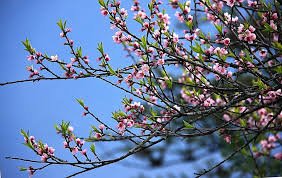Apr 3, 2024
Cherry Blossoms in Poetry and Classical Music
Cherry blossoms, with their ethereal beauty and transient nature, have long been celebrated as a source of inspiration for poets and composers in both Eastern and Western cultures. Across centuries, these iconic flowers have been immortalized in poetry and classical music, serving as symbols of love, beauty, and the passage of time.

1. Poetry:
- Cherry blossoms have inspired poets around the world to compose verses that capture the fleeting beauty and profound symbolism of these delicate flowers.
- In Japan, cherry blossoms, known as “sakura,” feature prominently in classical Japanese poetry such as haiku and tanka. Poets like Matsuo Basho and Yosa Buson often used cherry blossoms as a metaphor for the transience of life and the beauty of fleeting moments.
- In the West, cherry blossoms have been celebrated by poets such as William Wordsworth, who wrote about the arrival of spring and the blooming of cherry trees in his famous poem “Lines Written in Early Spring.” Cherry blossoms also appear in the works of poets like Emily Dickinson, who used them as symbols of beauty and renewal.
2. Classical Music:
- Cherry blossoms have inspired composers to create music that evokes the delicate beauty and emotional resonance of these iconic flowers.
- In Japan, cherry blossoms have been depicted in traditional Japanese music such as “Sakura Sakura,” a folk song that celebrates the beauty of cherry blossoms and the arrival of spring. The melody of “Sakura Sakura” has been arranged and adapted by numerous composers and musicians over the years.
- In Western classical music, cherry blossoms have been portrayed in compositions such as Pyotr Ilyich Tchaikovsky’s “Sérénade mélancolique,” which captures the melancholy and wistfulness associated with the fleeting beauty of cherry blossoms. Additionally, composers like Claude Debussy and Maurice Ravel have evoked the ephemeral nature of cherry blossoms in their impressionistic compositions, using delicate melodies and lush harmonies to create musical portraits of springtime.
3. Symbolism and Themes:
- Cherry blossoms symbolize a range of themes and emotions in poetry and classical music, including beauty, transience, love, and the passage of time.
- In poetry, cherry blossoms are often used as metaphors for the impermanence of life and the beauty of fleeting moments. Poets use imagery of cherry blossoms to evoke a sense of nostalgia, longing, and appreciation for the ephemeral beauty of nature.
- In classical music, cherry blossoms inspire composers to create music that reflects the delicate beauty and emotional resonance of these iconic flowers. From tender melodies to lush harmonies, cherry blossoms are portrayed in music as symbols of renewal, hope, and the eternal cycle of life.
Conclusion:
- Cherry blossoms have captivated the hearts and minds of poets and composers for centuries, inspiring timeless works of poetry and classical music that celebrate the beauty and symbolism of these iconic flowers. Whether in Japan, the West, or beyond, cherry blossoms continue to inspire artists to create art that reflects the profound truths of nature and the human experience.